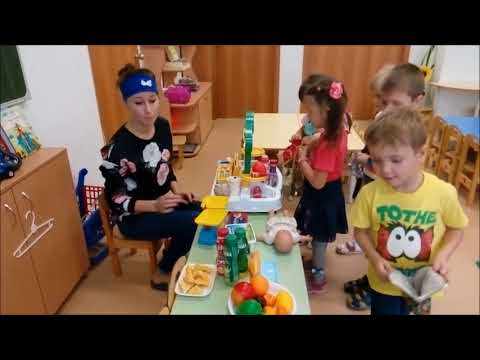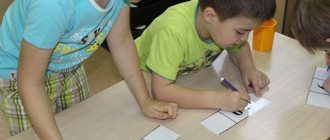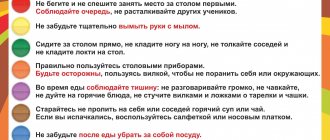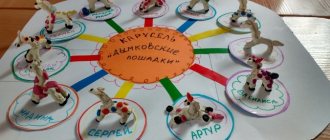Methodology for preparing and conducting theatrical performances
The texts of fairy tales and poems are the basis of creative games. Moreover, many of the works are already well known to the children from last year and even the year before (“Turnip”, “Teremok”). But nevertheless, several types of fun are played on their basis. So, for example, “Turnip” can be made into a director’s board game on flannelgraph, or a dramatization, or a tabletop theater performance. Moreover, all types of games can be shown to children with minimal participation from the teacher.
Table: card index of theatrical performances in the middle group (fragments)
| Name | Type of game | Target | The essence of the game (props) | In what classes is it used? |
| "Mirror" | Dramatization (imitation) | Development of monologue speech. | Parsley asks a riddle: It shines and glitters, It doesn’t flatter anyone, But it will tell anyone the truth - It will show him everything as it is! What is this? (Mirror) A large mirror is brought into the group (hall). Each member of the team approaches the mirror, and, looking into it, the first one praises himself, admires himself, the second one talks about what he doesn’t like about himself. Then members of the other team do the same. (mirror) | Speech development, physical education, music, choreography |
| "Kolobok", "Teremok" | Dramatization (staging) |
| Children act out the plot of a fairy tale without the teacher reading the text in parallel. Note: the teacher can suggest the order in which characters appear. (caps of fairy tale heroes) | Entertainment, walk, matinee, speech development lesson |
| "Turnip" | Director's room (cone theater) |
| Children show the plot of a fairy tale without text accompaniment from the teacher, that is, the essence of the performance is played out by the playful actions and words of the participants. (dolls on cardboard cones) | Speech development, music, entertainment. |
| "Cat and Mouse" | Director's room (puppet theater, glove puppets) |
| The children's actions are accompanied by the text told by the teacher or the child: This pen is a Mouse, This pen is a Cat, We can play cat and mouse for a little while. The mouse scratches with its paws, the mouse gnaws the crust. The cat hears this and sneaks up to the mouse. The mouse, having grabbed the cat, runs into the hole. The cat sits and waits: “Why isn’t the Mouse coming?” | Speech development, familiarization with the outside world |
| "Cat house" | Director's room (stand on flannelgraph) | Learn to perform simple performances, assume the role of a director, and use expressive means of speech to embody the image: intonation, tone of voice. | Children act out the story using pictures to match the text narrated by the child authors. | Speech development |
Issues of individualization in theatrical games
Even in such a group type of work as a game, the teacher must individualize the task. This can be achieved thanks to:
- choosing a role (to find his role, the child must try on all the roles, which ensures the creation of a situation of success),
- attributes (those children who do not want to transform into an image under any circumstances may be responsible for selecting props),
- reading by heart (at 4–5 years old, children are able to learn and memorize fairly large texts, so theatrical activities can be accompanied by the recitation of poems).
If there are children in the group who do not like public speaking, they can be given tasks related to preparing the scenery
Time plan
A theatrical performance in an average group takes up to 7 minutes. The exception is dramatizations, as well as some types of director's games, for example, productions with puppets. In this case, gaming activity should not exceed 20 minutes.
Theatrical play includes four stages of organization.
- Presentation of the game - from 1.5 to 3 minutes. During this time period, the teacher motivates the children and also addresses the basic knowledge of the students.
- Explanation and playback by the teacher of the actions of each of the participants in the production - from 1 to 3 minutes.
- The game itself lasts from 3.5 to 12 minutes. When working with children of middle preschool age, the teacher’s participation directly in the game is about 20%: the adult is present at the level of hints and reading the accompanying text.
- The final stage is 1–2 minutes. The teacher evaluates the work of each participant and asks the kids about their impressions of the game.

Well-known plots enable children to show greater independence when preparing the game.
Table: example of compiling a summary of the theatrical production “Zayushkina’s Hut” in the middle group (fragments)
The author is Markova S., teacher of the MBDOU “Kindergarten No. 10 “Fairy Tale”, Alatyr, Chuvash Republic.
| Stage | Content |
| Game presentation | “Guys, today, when I approached the group, I met the postman. He gave us a letter. Do you want to know from whom? (We want). By looking at the envelope, you can guess who sent this letter. Who is it from? (He was sent by Baba Yaga). Let’s find out what she’s writing to us.” (The teacher reads a letter from Baba Yaga). - As you already guessed, I am writing the letter - Baba Yaga. I like to do different dirty tricks. So in the envelope there are characters from one fairy tale, I enchanted them and turned them into rectangles. If you guess which fairy tale characters I enchanted and you can revive them, then a surprise awaits you, and if you don’t guess, I will turn you all into stones. After all, I am flying in a mortar and slowly watching you through the windows... If you complete the task, you will hear the sound of a bell, which means you will be able to read the letter in a small envelope. I wish you success. Baba Yaga. Teacher: “Guys, are you a little scared? Are you scared? I'm scared, but let's not be discouraged, let's look at the enchanted rectangles. Look at them carefully and maybe you will find out what kind of heroes they are and what fairy tale they are from? I also think that the heroes are from the fairy tale “Zayushkina’s Hut”. We are familiar with this fairy tale. Please tell me what the fox was like in the fairy tale “Zayushkina’s Hut?” (Cunning, evil, angry, deceiver). Where did her cunning come into play? (I came to stay, but she kicked out the hare.) What was the bear like in the fairy tale? (Clumsy, clubfooted, kind)…>, |
| Explanation | <,... Let's play this fairy tale and bring our heroes to life. There is not enough scenery to perform on stage. Who will be the decorators who will help decorate the stage with decorations...>, |
| A game | <,...Sit back, watch and listen: “Once upon a time there was a fox and a hare...”...>, |
| The final stage | <,…- You completed the tasks. Well, as I promised, a surprise awaits you. Look for it in your group in a chest, and to open the chest, you need to say the magic words: “Rex, pex, fex.” (They look for a chest, say magic words, open it and take out a treat). |
| https://www.maam.ru/detskijsad/teatralizovanaja-igra-zayushkina-izbushka.html | |
Video: dramatization (staging) of the fairy tale “Teremok” in the middle group
https://youtube.com/watch?v=bmnfxO-ykA0
Classification of theatrical games
All theatrical games are divided into two groups:
- those in which children appear as characters, that is, dramatizations,
- those in which children act as directors, organizing the actions of dolls and toys, that is, directing.
Both in dramatizations and in director's games, separate types are distinguished.
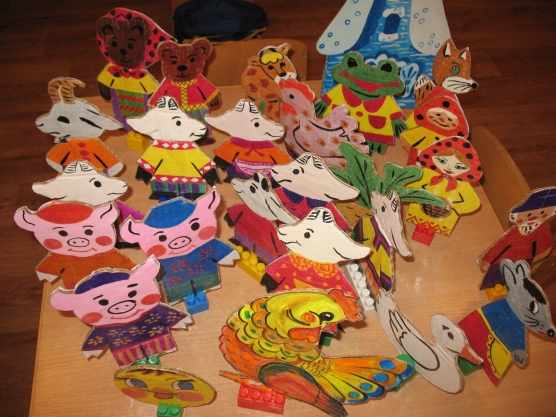
Of all types of theatrical games, director's games on flannelgraph allow one to show independence to a greater extent and therefore are liked by middle group students more than others.
Table: main types of theatrical games in the middle group
| Group | View | The essence of the game |
| Dramatization | Imitation | If in the younger groups these games consisted of imitating the behavior of animals, then in the middle group the creation of clichéd images is added: old grandmothers, capricious children, fashionistas, etc. |
| Role-playing | Children appear in images that are familiar to them from everyday life: doctors, salesmen. They also try on different social roles: mother, father, child, grandmother, etc. | |
| re-enactment | Kids show the plot, role-playing it. In the middle group, the words of the characters can be in poetic form, as was the case in the second junior group, and in prose, which is due to the greater degree of independence of the children and their full awareness of the essence of game actions. | |
| Director's | Desktop | The “artists” are dolls, toys, and natural material in the images of characters (for example, hedgehogs made of cones, buns made of chestnut, etc.). |
| Puppet | Game actions are performed on behalf of puppets: glove puppets, finger puppets, spoon puppets, etc. | |
| Bench | The plot is played out on a flannelgraph or magnetic board from the faces of the characters in the pictures. Such “artists” are attached to the stand with Velcro or magnets. | |
| Conical | Children perform game actions on behalf of characters on cardboard cones. |
This is interesting. In the middle group, children’s gender self-identification enters an active phase, so boys choose “boyish” toys: cars, toy soldiers, and do not accept “girly” characters. At the same time, girls are more loyal to toys of the opposite sex and sometimes are not averse to gathering a tin army to defeat the rat king or the evil dragon.
Video: role-playing game “In the store” in the middle group
